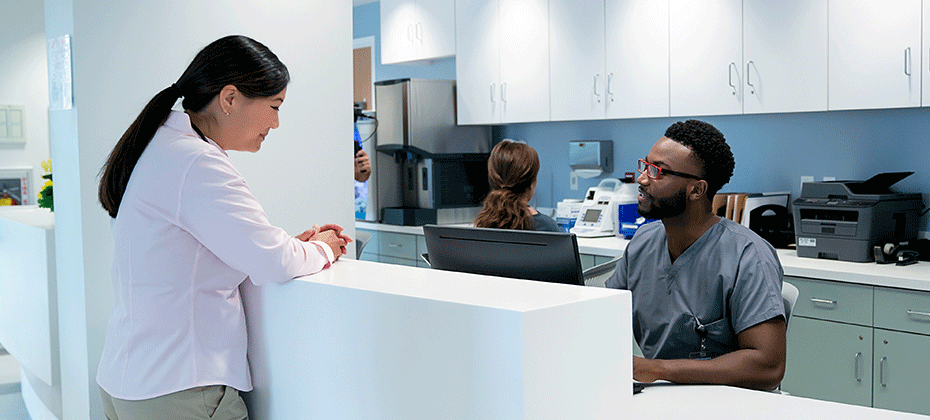Collections Optimization
Boost revenue, streamline patient financial assistance, and reduce collection costs.

Many healthcare providers believe pairing “revenue cycle” with a qualifier like “predictable” is an oxymoron. From healthcare staffing shortages that slow down reimbursement tasks to increasing payer denials, financial regularity can seem like an unattainable goal for these organizations. The American Hospital Association (AHA) reports over one-half of U.S. hospitals had financial losses in 2022. Another AHA survey shows that 84% of these organizations say the cost of complying with complicated payer policies is climbing. Providers throw an excessive amount of time and staff at chasing revenue, but reimbursement complexities make for anything but smooth financial sailing. How can healthcare providers even out the ebbs and flows of the revenue cycle? Experian Health's suite of revenue cycle management (RCM) solutions can help. Revenue cycle predictability during the life of a claim When it comes to finances, U.S. healthcare providers rarely have an easy go of it. Today, the average life of a claim is anything but average. From registration to collections, hospitals established a new normal over the past decade: Widening gaps between service delivery and reimbursement. How can providers tackle this untenable situation? The answer is two-fold: with technology and at each stage of the life of a claim. Here are three ways healthcare providers can use technology to create reimbursement predictability at each stage of a claim's life. 1. Establish payment accountability at patient registration with price transparency Reimbursement problems begin at patient registration. Healthcare price transparency demands patients understand the cost of care. According to Experian Health's State of Patient Access survey, 81% of patients agreed that an accurate estimate helps them better prepare to pay for their care costs. However, only 31% of patients received a cost estimate before care. There are three significant impacts of this troubling trend: Nearly 40% of patients say they put off needed care due to cost. The number rises to 61% if the patient is uninsured. Patients can't afford to pay for needed care. Currently, 41% of U.S. adults have medical debt. An Experian Health study showed four in 10 patients spend more than they can afford on healthcare treatment. Uncompensated care causes a significant drop in healthcare provider income, which has amounted to almost $745 billion, according to the AHA. Experian Health offers several data-driven solutions to improve price transparency. These tools make it easier for patients to handle their financial responsibilities while helping providers find solutions to help ease their burdens.Patient Financial Advisor creates more accurate service estimates for patients before their procedure. The mobile-first platform offers patients a detailed cost breakdown on their preferred digital device. Patient Estimates is a web-based platform offering real-time service estimates. Blessing Health System uses the tool to provide patient estimates that are up to 90% accurate. The provider increased collections by 58% and credits the software with a 1,200% return on their investment. Patient Access Curator automatically initiates communication with payers to improve coordination of benefits and maximize return. It also automatically identifies missing or incorrect Medicare Beneficiary Identifier (MBI) numbers or errors in patient contact details. This solution also helps providers understand the patient's ability and propensity to pay, allowing these organizations to predict revenue streams after service delivery. Behind the scenes, Experian Health also automates insurance eligibility verification to unlock hidden reimbursements. This software roadmaps the correct coverage, connects to more than 900 payers and verifies insurance coverage at the time of service to improve cash flow and ease patient payment burdens. 2. Reduce claim denials by decreasing manual paperwork errors Claim denials are one of the biggest impediments to revenue cycle predictability. Providers are stuck in an endless cycle of inaccurate payer submissions, rejected claims, and rebilling, creating a chaotic chase for payment long after the service. Today, 35% of healthcare organizations report $50 million or higher in lost revenue due to claims denials. Even worse, Experian Health's State of Claims 2022 report showed that 30% of providers say denials are increasing by up to 15%. According to that data, the top three reasons for claim denials are: Missing or incomplete prior authorizations. Failure to verify provider eligibility. Coding inaccuracies. Experian Health's Claim Scrubber software levels out provider cash flow, creating predictability amidst the chaos. The solution reviews complete claims for errors, generating actionable edits before submission. Claim Scrubber also reviews approved reimbursement rates to prevent undercharging. Transactions process within three seconds and providers reduce the need to rework claims. Experian Health's AI Advantage solution uses the power of artificial intelligence (AI) to evaluate every claim for its propensity to turn into a denial. Instead of submitting claims and hoping the payer will accept them, this solution takes the guesswork out of reimbursement for a more rational, predictable process. The software automatically scans for payer updates to reimbursement requirements that significantly contribute to claims denials. Hospitals like Schneck Medical Center use this tool to streamline the revenue cycle by preventing denials. After just six months, the provider’s denied claims reduced by an average of 4.6% each month. Claim corrections that took up to 15 minutes manually are now processed in less than five. 3. Increase collections efficiency with automation Patients trust their healthcare providers to take care of them. Providers also rely on patients to pay their bills. It's a mutually beneficial arrangement. However, it's also a problem forcing providers to walk a delicate tightrope between caring for a sick patient while still chasing payment for their services. Unfortunately, the increasing cost of healthcare leaves patients on the hook for more than $88 billion in debt. The volume of healthcare payments in arrears is staggering, causing a substantial drain on provider cash on hand. However, technology offers healthcare providers a way to improve the patient collections process. For example, Coverage Discovery impacts the revenue cycle at every stage of the claim: Before providing care, the software scans patient data to determine reimbursement coverage options from Medicaid, Medicare, and commercial insurance. It scans for active insurance 30, 60, and 90 days after care delivery. The tool scans patient data before determining whether the account moves to bad debt collections. A more robust understanding of patient payment options at every stage of claims management allows healthcare providers to forecast reimbursements more accurately, increasing the predictability of the revenue cycle. Collections Optimization Manager provides organizations with actionable insights, so that providers can segment and prioritize accounts by proprensity to pay. This solution increases patient collections by leveraging Experian's data driven segmentation models, and helps providers screen out bankruptcies, deceased accounts, Medicaid and other charity eligibility ahead of time. Experian Health's AI Advantage – Denial Triage prioritizes rejected claims based on their yield potential, automating workflows for claims managers so they focus first on the patients more likely to pay. This tool segments denials based on their potential value to help even out the revenue cycle with a faster rate of financial return. Denial Triage expedites A/R by increasing revenue collection per person per hour. Revenue cycles can be more predictable, but the complexities of reimbursement require technology to achieve this goal. Experian Health offers a comprehensive line of revenue cycle management solutions to help healthcare providers maximize collections and improve RCM. Find out why Experian Health ranks Best in KLAS for 2024 in the categories of Claims Management & Clearinghouse and Revenue Cycle: Contract Management, or contact us for a more predictable revenue cycle, better cash flow, and a healthier organization.

The ecosystem of healthcare revenue management involves the entire lifecycle of medical billing. It starts with patient scheduling to encounters, then moves to coding and medical billing. However, understanding the basics of medical billing isn't just for the back-office team: it's vital for front-office staff too, especially those dealing directly with patients. Many patients arrive with coverage from multiple payers and high deductibles, which makes claims and collections processes increasingly complex. Providers that get the billing basics right can deliver a better patient experience while setting themselves up for financial success. Discover the key steps in the medical billing cycle and learn how healthcare providers can improve efficiency, streamline collections, and increase profits from appointment scheduling to payment completion. What are medical billing basics? Medical billing is about ensuring providers get paid for the services they provide, whether that be submitting claims to payers or invoices to patients. The workflow may be broken down into three phases: Front-end medical billing: The process starts with patient intake and registration. During this process, staff collect relevant information about the patient, their coverage, and their diagnosis and treatment. They must know what payers require in terms of claims documentation so they can collect the right data upfront. At this time, staff will also inform patients of their financial responsibility, so patients are prepared for their upcoming bills, or can make payments before service.yr45 Back-end medical billing: This part of the cycle occurs after the encounter. Once it's documented, medical coders and billers use information obtained during registration to figure out who pays what toward the final bill. Coding rules and documentation requirements vary considerably, depending on payer type (commercial, government or self-pay) and individual payer policies, so many organizations use automation and artificial intelligence to increase medical billing accuracy and minimize denials. These tools also support the claims adjudication process. Patient collections: If there are any remaining balances after insurance reimbursement, healthcare organizations generate bills for patients. These detail the services provided, the amount already covered by insurance, and any outstanding balances owed by the patients. Increasing numbers of self-pay patients with high deductibles put new pressure on patient collections, and managing the workflow is challenging without technology, data and analytics. Healthcare organizations struggle to collect more than one-third of patient balances greater than $200, which makes understanding how to improve medical billing is essential. What’s the relationship between the medical billing revenue cycle, successful billing and patient collections? Within the medical billing revenue cycle, there are opportunities to maximize efficiency and accuracy, with tangible benefits for staff, patients, and those with an eye on profits. These opportunities rely on bridging the gaps between the three phases above with reliable data and integrated workflows. Some strategies and tools include: Find missing coverage: Proactively identifying billable government and commercial coverage is a huge relief for patients, who won't be billed for amounts that could be paid via alternative sources. Additionally, providers are more likely to be reimbursed. Coverage Discovery uses multiple proprietary databases to scan for missing or forgotten coverage throughout the patient journey. In 2023, this solution tracked down billable coverage in 32.1% of patient accounts, resulting in more than $25 million in previously unknown coverage. Tailored payment options for patients: Providing upfront pre-service cost estimates for patients gives them clarity about what they'll owe so they're less likely to be shocked when they receive their bill, and are more likely to pay on time. Patient Payment Estimates generates quick, accurate pricing estimates along with a clear breakdown of how the costs have been calculated and secure links to instant payment methods. Helping patients find financial assistance: From the first encounter, patient financial data can be interrogated to determine whether they may be eligible for financial assistance. Getting them on the right pathway from the start means they're less likely to delay and default on bill payments. Flexible payment plans: Research from Experian Health and PYMNTS shows patients are eager for flexible ways to pay. Rigid and protracted processes are inconvenient for patients and often end up multiplying medical debt, which is bad news all round. Simple self-service tools can meet patients where they are and help them manage their bills, whether they prefer to pay in full and up front, or they need to break it into more manageable instalments. This reduces payment delays and lessens the medical debt burden on all parties. Streamlined, secure payments: PaymentSafe® accepts secure payments anywhere, anytime, using eChecking, debit or credit card, cash, check and recurring billing – all through a single, easy-to-use web tool. Every patient encounter becomes an opportunity to collect payments with minimal fuss. Automated patient outreach: An easy win with automation is to issue appropriate reminders to patients about upcoming and overdue payments. Automated dialing and texting campaigns mean patients get relevant information through convenient channels, and staff can focus on more complex collections cases. Strategic collections management: Segmenting and prioritizing collections accounts based on propensity to pay allows staff to spend their time where it matters most. Automation and data analytics can be used to route accounts to the correct pathway, resulting in a more compassionate patient experience, better use of resources, and increased collections overall. Identifying inefficiencies in medical billing To select and implement the above strategies and RCM medical billing solutions, it's important to identify where inefficiencies and gaps are in the process. Some questions to consider are: Are we relying too heavily on manual entry in our billing activities? What are the root causes behind our medical billing errors? Are our tracking and reporting efforts throughout the billing lifecycle? How accurate are our payment estimates and eligibility verification processes? Are our current payment acceptance practices and plans effective? How successful and compassionate are our patient outreach efforts? By assessing each area, providers can pinpoint opportunities to simplify the medical billing workflow and use revenue cycle management technology to accelerate collections. Optimize patient collections with the Collections Optimization Manager One specific example of how healthcare organizations can improve patient collections is with Collections Optimization Manager, which uses data analytics to manage the medical billing basics and customize collections strategies. The platform streamlines patient collections by screening out bankruptcies, deceased accounts, Medicaid and other charity eligibility, so staff don’t waste time chasing payments. Remaining accounts are grouped and routed to the most appropriate pathway, so they can be dealt with quickly and effectively. Case study: See how St. Luke's University Health used Collections Optimization Manager to collect an additional $1.2 million in average monthly collections,, in the midst of staffing shortages. Explore more ways to use Collections Optimization Manager to streamline the medical billing basics and accelerate patient collections.

More than 13 million Americans have lost Medicaid coverage since continuous enrollment came to an end in April 2023. Unwinding the emergency provisions requires states to determine which individuals remain eligible for Medicaid, leading to widespread disenrollment. The Medicaid redetermination process created a major admin burden for agencies and providers, and now, the impact of that burden on patients has become clear: more than 7 million of those who lost coverage were disenrolled because of administrative processes, and not due to ineligibility. While some will find coverage elsewhere, many will be left without insurance. These coverage gaps disrupt health services with adverse effects for patients and providers. In a recent webinar, Kate Ankumah and Mindy Pankoke, Product Managers at Experian Health, reflect on the Medicaid redetermination process and discuss how providers can mitigate the effects of redetermination heading into 2024. Recap: Medicaid continuous enrollment provision timeline How does the Medicaid redetermination process work? The redetermination process, led by state agencies, involves reviewing Medicaid rosters and automatically renewing coverage for individuals that still qualify, based on benefits or other government data. When coverage cannot be confirmed automatically, states need to reach out to patients to fill in the gaps. If the individual is no longer eligible (or does not provide the necessary data), they will be removed from coverage lists. Many patients are confused about the process and may not even realize they're no longer covered, leading to delays and distress when they try to access care. This blog post breaks down the 5 things providers can do if a patient loses Medicaid coverage. 1. Tighten up insurance eligibility verification processes During the webinar discussion, Kate Ankumah explains that implementing a reliable eligibility verification tool is essential to reduce financial risk, increase revenue and streamline staff workflows: “With our Eligibility product, we connect to more than 900 payers with search optimization. Providers don't need to send the same information over and over – we'll run through the search options ourselves and find the information as quickly as possible. Then we standardize the data so front desk staff can read all the responses in the same way. We also build in alerts. A couple of clients have alerts set up for Medicaid redetermination dates that pop up if a patient is due for redetermination so the front desk staff know to have a conversation with them about it.” Eligibility also includes an optional Medicare beneficiary identifier (MBI) lookup service, to check if any patients who may have been disenrolled from Medicaid are now eligible for Medicare. 2. Find missing coverage with Coverage Discovery Providers may also want to automate the search for any active coverage that may have been overlooked. Coverage Discovery searches for possible billable government or commercial insurance to eliminate unnecessary write-offs and give patients peace of mind. Using advanced search heuristics, millions of data points and powerful confidence scoring, this tool checks for coverage across the entire patient journey. If the patient's status changes, their bill won't be sent to the wrong place. In 2021, Coverage Discovery identified previously unknown billable coverage in more than 27.5% of self-pay accounts, preventing billions of dollars from being written off. 3. Quickly identify patients who may be eligible for Medicaid and financial assistance The lack of clarity around enrollment and eligibility is disruptive for claims and collections teams. How can they handle reimbursements and billing efficiently if financial responsibility is unclear? Denial rates are already a top concern for providers, and staff cannot afford to waste time seeking Medicaid reimbursement for disenrolled patients. Patient collections also take a hit when accounts are wrongly designated as self-pay. With Patient Financial Clearance, providers can quickly determine if patients are likely to qualify for financial support, then assign them to the right financial pathway, using pre- and post-service checks. Self-pay patients can be screened for Medicaid eligibility before treatment or at the point of service, and then routed to the Medicaid Enrollment team or auto-enrolled as charity care if appropriate. Post-visit, the tool evaluates payment risk to determine the most suitable collection policy for those with an amount to pay and can set up customized payment plans based on the patient's ability to pay. Patient Financial Clearance also runs back-end checks to catch patients who have already been sent a bill but may qualify for Medicaid or provider charity programs. This helps secure reimbursement and means patients are less likely to be chased for bills they can't pay. 4. Screen and segment patients according to their propensity to pay Optimizing collections processes is always a smart move for providers, but particularly now that federal support has ended. Collections Optimization Manager uses advanced analytics to segment patient accounts based on propensity to pay and send them to the appropriate collections team. Drawing on Experian's consumer credit data, Collections Optimization Manager's segmentation models are powered by robust and proprietary algorithms. These models screen out Medicaid and charity eligibility, so collections staff focus their time on the right accounts. Case study: See how University of California San Diego Health (UCSDH) increased collections from around $6 million to over $21 million in just two years using Collections Optimization Manager. 5. Make it simpler for patients to manage and pay bills The reality is that many patients affected by the unwinding of continuous enrollment will be on low incomes. When more than half of patients say they'd struggle to pay an unexpected medical bill of $500, providers should make it easier for patients to gauge their upcoming bills. Patient Financial Advisor and PatientSimple® can help patients navigate the payment process with pre-service estimates, access to payment plans and convenient payment methods they can access on a computer or mobile device. Together, these tools can help providers manage Medicaid changes efficiently and offer extra support to patients who may be facing disenrollment. Watch the webinar to see the full discussion on how Medicaid redetermination is affecting providers and find out how Experian Health's digital solutions can help healthcare organizations quickly and easily verify insurance coverage.

Between November 2022 and September 2023, St. Luke's University Health Network (SLUHN) saw a 22% uplift in self-pay collections, amounting to an additional $1.2 million in average monthly collections. What makes this particularly noteworthy is that they achieved this during ongoing staffing shortages. It's an encouraging result for providers facing similar challenges, so how did they do it? On a recent webinar with Experian Health, Cindy Samuels, Senior Manager of Patient Revenue Services at St. Luke's, and Rich Wade, Strategic Product Consulting Director at Experian Health (and the Patient Revenue Services team's designated consultant), share how Collections Optimization Manager and PatientDial allowed St. Luke's to automate and optimize their collections efforts. How staffing shortages wreak havoc on the collections process Revenue cycle managers are all too familiar with the downward trend in collections recoveries over the last few years, which is exacerbated by labor shortages and rising self-pay balances. In Experian Health's August 2023 survey, Short-Staffed for the Long Term, 100% of respondents said that staffing shortages had affected revenue cycle management. Many reported that resource shortages in patient collections made it harder to follow up on late payments or help patients who were struggling to pay. With six vacancies in their own Patient Revenue Services team, St. Luke's needed a way to improve efficiency. Cindy Samuels says, “more and more dollars were falling to the patient. I had a team of folks making outbound phone calls to collect outstanding dollars, but staff were leaving messages all day long and our cash wasn't increasing. Outsourcing wasn't an option that we wanted to pursue, so we looked at technology automation.” Since St. Luke's were already using Experian products in other parts of the revenue cycle, replacing their outdated call center platform with an Experian Health solution made sense. Developing a successful strategy for collecting self-pay balances To handle increasing self-pay balances with limited staff resources, St. Luke's used Collections Optimization Manager to generate a daily accounts receivable (AR) file and then screen, segment and monitor accounts so they could be managed in the most efficient way. Samuels explains: “Every active self-pay account goes through [Experian's] scrubbing system, so they're finding medical assistance, presumptive charity, deceased bankruptcy, and other types of insurance. So, we know to set those accounts aside. The rest are segmented into five segments [based on propensity to pay] so I know where to put my resources when it comes to reaching out to patients.” With the help of an Experian Health consultant, Collections Optimization Manager users can then implement specific collections strategies that are tailored to each segment. For St. Luke's, this included automating patient calls using PatientDial, a cloud-based call system that facilitates inbound, outbound and blended call environments to help collect patient balances. The combination of segmentation and automation allows St. Luke's to have multiple call campaigns running at once, so more patients can be contacted and in a way that is more likely to lead to payment. Maximizing collections by shifting focus from “high dollar” to “ability to pay” Typically, collections teams focus on aged accounts with the highest dollar amounts. Unfortunately, this can result in staff chasing accounts that are unlikely to be paid. Collections Optimization Manager's segmentation strategy means accounts are sorted according to likelihood of payment, and treated in a way that is more likely to yield results without wasting staff time. With Collections Optimization Manager and Patient Dial, patients that are more likely to pay can be allocated to an unassisted call campaign and given an automated reminder about their balance at the appropriate time. It may not make sense to have staff spend time calling patients at the other end of the spectrum who are unable to pay or even engage with the process. An automated message with information about financial assistance may be a more appropriate approach. St. Luke's focused their resources on the segments in the middle, who are likely to be engaged but may have specific issues to resolve, such as needing details of payment plans or updating a credit card. This approach has helped the team reach more patients than ever and maintain an abandon rate of below 1.2%. Samuels says, “not only have we been able to collect more cash, but we've also been able to resolve more accounts, because with segmentation we've been able to clean up the AR that don't belong in the collections world. We can also help patients go down the financial assistance road if that's what they need. So maybe not every call results in cash, but at least we've been able to speak to patients and help them resolve any questions or concerns.” Boosting staff efficiency through automation Around 90% of St. Luke's Patient Services Team work remotely. This adds a new challenge for managers, who need to be sure that staff have the information they need to work confidently and effectively, while being able to monitor workloads and maintain productivity levels. While the increase in call volumes and collections speaks to the boost in productivity, PatientDial's reporting function has made it possible to generate a scorecard for each representative to measure performance. This allowed Samuels to identify potential training needs and foster knowledge exchange, especially when remote working means staff can't simply ask the person next to them for help. Samuels says her staff have welcomed the ability to handle more calls, more efficiently, without having to redial patients several times. PatientDial provides user-friendly dashboards, so call center agents have all the necessary details at their fingertips. Staff have said they find it motivating to be able to help more patients, which is reflected in high employee satisfaction scores in St. Luke's annual employee engagement survey. A snapshot of success In addition to increasing average monthly collections by $1.7 million in a little under a year, St. Luke's has seen the following results: “We have increased our outbound call volume by 274% since last November, so we're reaching more patients. If we're not reaching them, we're leaving more messages. The dialer has also saved 740 hours monthly because staff are no longer dialing numbers and getting nothing. And we’re using an interactive voice response (IVR) campaign for payments, so we've saved around 253 hours each month, because patients make their payment electronically over the phone with no need to speak with a representative. It was a very positive thing for us.” Cindy Samuels provides more details of their approach on the webinar, plus her tips for others who may be considering implementing Collections Optimization Manager and PatientDial in future. Watch the webinar for full details on how St. Luke's increased collections despite staffing shortages, or contact us to learn how Experian Health can help optimize your collections efforts.

“We wanted the right technology that could look for insurance coverage for self-pay patients without the need for us to increase our manpower. The cost savings were a big win for the department.” — Brent Rikhoff, Director of Pre-Access, UCHealth Challenge UCHealth is an integrated health system with a network of 12 hospitals and more than 30,000 employees. At the height of the COVID-19 pandemic, UCHealth maintained its commitment to an excellent patient experience by giving all patients access to tests and vaccinations. Costs for uninsured and self-pay patients could be recovered under the Health Resources and Services Administration's (HRSA) COVID-19 Uninsured Program (UIP), but only after confirming that the patient had no relevant active coverage. If they missed this step, UCHealth would be landed with bad debt, increasing collection costs and unwanted audits: they needed a reliable way to track and verify insurance coverage accurately and in real-time. Solution UCHealth chose to use Coverage Discovery® after experiencing positive results with Experian Health's Eligibility solution. Coverage Discovery allowed them to scan the entire revenue cycle for billable commercial and government coverage that patients may have been unaware of or forgotten about. The tool gave UCHealth access to Experian's proprietary databases, including employer group mapping and patient search history, so they could track and verify potential coverage in multiple locations. This made it much easier to find insurance information for plans without a self-pay search feature. After seeing positive results, UCHealth expanded their use of Coverage Discovery to self-pay and emergency department patients. This helped them root out discrepancies in patient accounts and prevent accounts from being misclassified as bad debt or charity. Uncovering additional active coverage was also a major benefit for patients. Improving patient collections: strategies and best practices Discover the top 4 strategies to optimize patient collections while delivering a more compassionate financial experience for patients. Outcome Thanks to Coverage Discovery, UCHealth achieved the following results: Over $62 million in insurance payments in 2022, a 25% increase from 2021, includes payments from their top three payers $45 million in coverage found between May 2022 and May 2023 Over $3.5 million in collection costs savings in 2022 Overall, Coverage Discovery has helped UCHealth create a more streamlined approach to verification and billing. The batching feature made it easy for staff to process the backlog of patient accounts awaiting insurance verification, while access to large, current datasets facilitated more accurate billing. Director of Pre-Access at UCHealth, Brent Rikhoff, said the ability to integrate Coverage Discovery with Epic® enabled the team to achieve proper reimbursement for services rendered. Expanding the solution to include Medicaid coverage identification would be an obvious next step for UCHealth, following this impressive return on investment. Learn more about how Coverage Discovery identifies missing and forgotten billable coverage, so healthcare providers can get fully reimbursed while maintaining an outstanding patient experience. Learn more Contact us

Could common revenue cycle management (RCM) myths be preventing healthcare organizations from getting paid in full? Does what constituted best practice a few years back still apply to revenue cycle operations today? Many providers are embracing new technology to strengthen their RCM processes, using automations and software to create more accurate and efficient billing and claims management workflows. But if these processes are built on shaky assumptions, the results will be sub-optimal. As year-end financial reviews get under way, there is a prime opportunity to re-evaluate some long-standing beliefs about billing, collections and payments that, if not set straight, could limit financial performance in the year ahead. This article examines four of the most common revenue cycle myths and considers what providers can do to make financial growth a reality in 2024. Revenue Cycle Myth 1: All patients are equally likely to pay Reality: No two patients are alike – whether in their medical needs or financial circumstances. Providers know this, yet many rely on revenue cycle management solutions that lean toward a one-size-fits-all approach to patient payments. Instead, providers should consider RCM tools that use data and analytics to segment patients according to their individual financial situation, to create a more personalized and proactive approach to collections. This should take account of both the patient's ability to pay (i.e., whether they can afford their bills), and their likelihood to pay promptly, which may be enhanced by offering payment options that are convenient and aligned to their personal preferences. Collections Optimization Manager analyzes patients' individual payment history and demographic information so their accounts can be routed to the most appropriate collections pathway from the start. Patients that are likely to pay quickly can be sent billing information automatically and presented with self-service payment options. Alongside this, Patient Financial Clearance pulls together credit and non-credit data to help providers identify patients who may need a little more guidance and connect them to suitable payment plans. It catches any individuals who may be eligible for Medicaid or charity support. Staff get accurate, at-a-glance data to help them have sensitive financial conversations with patients, and can avoid losing time chasing collections from patients who would never have been able to pay. Case study: See how Stanford Health Care improved collections with a tailored, patient-focused approach to healthcare collections. Myth 2: It's hard to have meaningful pre-service financial conversations with patients Reality: Contrary to popular belief, most patients are receptive, and even eager, to have financial discussions with their provider as soon as possible. Doing so need not be challenging. In the past, providers may have worried that broaching the money question could deter patients from seeking necessary care, or simply not prioritized such discussions. Billing and insurance can also be highly complex, which may lead staff to assume that patients would find conversations about these issues to be confusing or overwhelming. But it is for these exact reasons that providers should have financial discussions with patients as early as possible. Experian Health's 2023 State of Patient Access survey found that almost 90% of patients wanted upfront pricing estimates so they could plan ahead for their financial obligations – yet less than a third received one. Tools like Patient Payment Estimates and Patient Financial Advisor can calculate cost estimates, taking account of the patient's claim history, deductibles and other insurance information, and automatically send these to patients before treatment so they know what to expect. These can also be combined with quick payment links so bills can be cleared before care. Giving patients consistent information through whichever digital channel they prefer means they will be better positioned to make informed decisions and discuss their situation with patient access staff if necessary. When patients are better informed and supported, they're also less likely to end up postponing care due to cost concerns. And with the same accurate data at their fingertips, patient access staff can serve as financial concierges, helping patients to understand coverage and copayments and check eligibility for relevant financial assistance programs. In addition to user-friendly data tools, providers should consider whether staff would benefit from additional training to bolster their confidence in leading compassionate financial conversations. Myth 3: It's impossible to know what patients owe across a system with a single look-up Reality: Thanks to data analytics and digital payment technology, it is now pretty straightforward to consolidate a patient's outstanding balance information from across an entire health system, and debunks common revenue cycle myths. Patient access staff can view a comprehensive summary of a patient's insurance status, estimated liability and open balances from multiple providers, enabling them to have meaningful financial conversations with patients. Even if these discussions do not lead to immediate payment, they can still act as a reminder to nudge the patient to act soon, thus accelerating the payment process. Selecting RCM tools from a single vendor makes it easier to integrate data from multiple workflows and generate a unified view of what a patient owes. When systems talk to each other, it's possible for a single tool to leverage the data and create a better experience for patients and staff. For example, PaymentSafe® automatically brings together data gathered throughout the revenue cycle to streamline what was previously a disjointed and time-consuming process. With point-to-point encryption, it accepts secure payments at any point in the patient's journey, using cash, check, card payments and recurring billing, through a single web-based application. Myth 4: Revenue cycle management is “set-and-forget” Reality: Revenue cycle managers may dream of setting up a system once and then forgetting about it, but the reality is that managing billing, claims and collections is an ongoing and evolving process that needs constant attention. Healthcare organizations must regularly review and adjust their RCM strategies to prevent missed revenue opportunities, manage compliance risks and promote operational efficiencies. That said, data analytics and automated revenue cycle management tools do make it far easier for providers to stay on top of RCM demands. These tools help providers with everything from monitoring payer policy changes and identifying billing errors to personalizing patient communications and generating monitoring reports. Artificial intelligence takes it a step further, for example, by preventing and predicting claim denials. In this way, these tools reduce the need for extensive staff input, so staff can spend more time focusing on the issues that need more human attention. With up-to-the-minute reports covering multiple RCM processes, staff also have the information they need to optimize performance and find opportunities to boost reimbursement that may have been previously overlooked. So, while RCM is not quite a “set-and-forget” process, automations and analytics can simplify it significantly, so it's less labor-intensive for staff and more efficient overall. Debunk revenue cycle myths and proactively challenge assumptions to increase profitability Debunking these revenue cycle myths is simple and achievable with tools that integrate a patient's clinical and financial data for a fuller picture of what that patient needs. This is crucial as changing consumer expectations, economic drivers, and new technology reshape how patients, providers and payers interact with one another. Checking underlying assumptions in any RCM process is essential to root out potential misunderstandings and outdated thinking. Not doing so leaves providers vulnerable to inaccurate financial projections, mismatched strategies and poor patient experiences. See how Experian Health's industry-leading Revenue Cycle Management Solutions make streamlined billing and collections a reality.

As retail and technology companies make moves in healthcare, existing providers must find new ways to attract and retain patients. Offering personalized patient payment plans is one way to meet evolving consumer demands and hold on to the competitive edge. The best part of this strategy? Providers can use data they already hold to deliver convenient and compassionate collections. Digital disruptors are driving a consumer-centric approach to healthcare payments Having transformed consumer expectations over the last decade, digital technology giants – along with a new generation of start-ups – are now actively pursuing a share of the multi-billion-dollar US healthcare market. Concierge medicine, on-demand virtual health and other personalized services are solidifying consumer expectations of flexibility, convenience and control. While consumers have more choice, they're also paying more for healthcare. Inflation-weary consumers are apprehensive about rising costs, and many report frustrations with healthcare billing and payment processes. According to a 2022 Gallup poll, nearly four in ten patients postponed medical care because of cost concerns. This tension between demand for choice and concerns about affordability leaves the sector vulnerable to disruption by players that offer alternative payment models that make healthcare more affordable for consumers, while making it easier to pay for care. Creating a more consumer-friendly approach to patient collections is essential for profitability. 1 in 10 patients use payment plans to manage the cost of care Research by Experian Health and PYMNTs shows that patients welcome payment plans to spread out the cost of care. One in ten patients had used a payment plan to pay for their most recent doctor's visit. Nearly three in ten older patients used a payment plan after receiving an unexpected bill. Unsurprisingly, those on lower incomes were most likely to need payment plans. Experian Health's State of Patient Access survey 2023 emphasized patients' desire for more flexible and transparent payment options, including pre-service estimates, payment plans and digital payment methods. Providers see the benefits too: around two-thirds of providers said their organization understands patients' unique financial situations and offers payment plans and financial assistance where appropriate. Using data to tailor patient payment plans For payment plans to work effectively, personalization is non-negotiable. Too often, payment plans apply a generic “one size fits all” formula to patient accounts, regardless of payment history, financial situation or other key indicators of the patient's ability to pay. This runs the risk of delivering a poor consumer experience while doing little to reduce patient bad debt. With a data-driven approach, healthcare organizations can identify the optimal plan for each patient. For example, PatientSimple® uses Experian Health's proprietary data and analytics to assess each patient's propensity to pay and guide them to the most appropriate financial pathway. A self-service portal gives patients a convenient way to generate estimates and consider different pricing plans, so they can make a more informed and confident decision about how to pay their bills. It also supports staff to have more compassionate financial conversations with patients. Similarly, Patient Financial Advisor and Patient Estimates give patients upfront, accurate estimates of what they're likely to owe, drawing on current chargemaster lists, payer contracts and the patient's insurance data. Together with payment plans, these estimates help patients avoid unexpected bills, so they have a more positive payment experience and are less likely to miss payments. A third tactic is to make it as easy as possible for patients to pay. Self-service and contactless payment options remove friction from the payment process, so patients are more inclined to pay promptly where they can. The patient's account data can be securely auto-populated into payment tools so they can pay and go with minimal fuss. Stay ahead of competitors by creating patient-friendly experiences As healthcare evolves, healthcare organizations need to develop strategies to remain competitive while still delivering compassionate care. Personalized patient payment plans are one way to strike that balance. Not only do they give patients the flexibility and convenience they’re looking for, but providers can also use existing data to tailor plans that benefit both company and customers alike. Alex Harwitz, VP of Product, Digital Front Door, at Experian Health, says these tools can help providers stay competitive as patients are exposed to a growing range of consumer-friendly healthcare services: “The move towards more patient friendly online experiences is a catalyst for improved price transparency. The challenge for providers is to adapt to shifting consumer needs while managing their resources wisely. But there's a major opportunity for providers to use data they already hold to help patients figure out the best financial pathway. Putting patients first is a sure-fire strategy to see patient satisfaction and patient collections rise in parallel.” Find out how healthcare organizations can remain profitable in an increasingly competitive market with personalized patient payment plans and patient payment solutions.

In July this year, the Centers for Medicare & Medicaid Services (CMS) reported that a data breach in a contractor's network may have compromised the data of more than 600,000 current Medicare beneficiaries. The breach, which occurred in May 2023, involved a vulnerability in file transfer software that enabled an unauthorized party to access beneficiaries' personally identifiable information (PII) and protected health information (PHI). Some patients were issued with new Medicare Beneficiary Identifiers (MBIs) following the incident. The contractor also offered two years of Experian credit monitoring at no cost to those affected. However, providers may see an increase in patients who are confused or concerned about using their MBI card. Experian Health's MBI Lookup service can help providers ensure that Medicare eligibility verification remains as efficient as possible. Thousands of beneficiaries issued new MBI numbers In response to the breach, CMS announced that 47,000 individuals would be mailed new MBI cards with new MBI numbers. However, as 612,000 patients were affected by the breach, there may be a significant number of people whose MBIs may change without notice. Since these individuals will not be able to use their old MBIs when trying to find Medicare coverage and benefits, there could be confusion among patients and providers who rely on MBIs to confirm a patient's eligibility for Medicare coverage. It could also affect billing processes and claim status inquiries. Experian Health reached out to CMS for clarification and received the following guidance: If a Medicare beneficiary's MBI number has changed, then their old (now inactive) MBI will return an AAA72 error when attempts are made to confirm coverage using the HIPAA Eligibility Transaction System (HETS). The HETS 270/271 platform will accept historical 270 requests that use the patient's new MBI. Old MBI numbers will only be accepted if that number was active during the Date(s) of Service noted on the request. Providers should note that some patients may inadvertently use invalid MBI numbers and review processes for verifying Medicare eligibility accordingly. Verifying Medicare eligibility with Experian Health's MBI Lookup tool Verifying active coverage can be a painstaking process, but it's a vital step to confirm that planned services will be covered by the patient's insurance provider. If a patient is unaware or cannot demonstrate eligibility for Medicare, then the provider cannot make a claim for reimbursement, and the patient may be left to pay a bill they cannot afford. Finding active coverage helps providers reduce the risk of bad debt. Experian Health's Insurance Eligibility Verification speeds up this process by accurately confirming coverage at the time of service. The process comes with an optional MBI Lookup feature, which checks transactions against MBI databases to see if the patient may be eligible for Medicare. If the patient has forgotten their MBI card, the tool will check to see if they're included in the database, using their name, date of birth, and Social Security Number (SSN) or Health Insurance Claim Number (HICN). The MBI Lookup service triggers on 270/271 transactions in the following cases: Where the transaction fails because the subscriber is not found or their MBI number or other identification is missing or invalid (a “Traditional Medicare Failure”) Where a commercial 270 inquiry returns a “Medicare Advantage Plan” or “Managed Care Plan” indication on the “Other Payer” or “Other Coverage” section of the 271 response Where a commercial 270 transaction returns a failed response and the patient is aged 65 or older. If the provider's system attempts to use a patient's old number, and the patient does not realize that they have a new number or card, MBI Lookup will find and verify their new MBI. When the tool is triggered, it finds active and verified MBI numbers in 60% of cases on average. Find coverage faster with automated discovery tools Kate Ankumah, Principal Product Manager of Eligibility Verification and Alerts at Experian Health, says the automated MBI Lookup service has proven especially useful during times of change: “Providers relied on this service to verify Medicare coverage quickly when the pandemic hit, just as the industry was adjusting to the use of MBIs instead of their legacy HICN. Now, MBI Lookup can help providers smooth out the impact of data breaches involving Medicare beneficiaries with minimal fuss. It's a reliable way to give patients clarity without placing any undue burden on staff.” Insurance Eligibility Verification can be used alongside other automated coverage identification tools, such as Coverage Discovery®. Coverage Discovery scans government and commercial payer databases throughout the patient journey to find any previously unknown or forgotten coverage, eliminating the need for manual inquiries. Using multiple sources of data and tried-and-tested algorithms, these tools work together to locate coverage for patients, giving patients peace of mind and helping providers avoid uncompensated care. Both tools can be accessed via the eCareNext® platform, so staff can view eligibility responses and manage work queues through a single interface. And of course, this recent breach is a stark reminder of the need to protect patient data. Using a single vendor with integrated software and data solutions can help reduce the risk of data getting into the wrong hands. Find out more about how Experian Health's Eligibility Verification solution and MBI Lookup tool can help providers verify active coverage and give patients peace of mind following a data breach.

The healthcare staffing crisis was one of the biggest challenges facing healthcare providers pre-pandemic, only to be exacerbated by the pressures of dealing with the COVID-19 crisis. Almost a fifth of healthcare workers resigned between February 2020 and September 2021. Unfortunately, the problem isn't in the rearview mirror yet – a new study from McKinsey reveals that worker shortages persist, with 31% of nurses declaring their intent to leave their jobs in the next year. These shortages put pressure on remaining staff, compromise hiring efforts and make high-quality services difficult to maintain. Without a thriving, vibrant workforce, how can healthcare providers meet the needs of their patients? Can automation help address the healthcare staffing crisis? Stubborn staff turnover levels aren't unique to healthcare, but addressing them is even more critical, given the detrimental effect on patients. As the staffing crisis shows no signs of letting up, providers should consider how technologies that leverage automation and AI can help. Tom Cox, President at Experian Health, says, “Automation has transformed many aspects of healthcare, from driving down appeals and denials to improving the digital front door. We're now seeing AI starting to make waves, too. These technologies are the future and are changing healthcare for the better.” Opening healthcare's digital front door is a good place to start. By eliminating repetitive and time-consuming tasks like data entry, manual patient registration and prior authorizations, staff will be freed up to focus on what matters most: delivering high-quality patient care. Here, we look at three areas where automation can simultaneously alleviate the burden of staff shortages and create a better patient experience. Use case 1: automate patient access to manage the growing demand for services Manual and repetitive processes eat up valuable time and create greater workloads that contribute to staff burnout. This is especially true in patient access, which is a typically admin-heavy process. Allowing patients to complete more of their registration and scheduling tasks themselves can reduce the workload in understaffed teams. Many patients prefer not to book appointments through call centers, and high call volumes are a major pressure point for staff. Similarly, manual patient registration is labor-intensive and error-prone, eating up staff time and creating bottlenecks for patients. Automated registration and self-scheduling solutions help patients access care without waiting in phone queues. Patients can book, cancel and reschedule appointments through their mobile devices. On the back end, data can be leveraged to predict and manage demand, while digitized scheduling means agents can spend less time checking referrals against scheduling rules. Automated prior authorizations mean staff no longer need to spend hours poring over payer policies and checking individual payer websites to check for changes – the software updates automatically in real-time. Simplifying these processes with automation not only minimizes operational strain but also reduces friction for patients who want to see the right specialist in the least amount of time. Use case 2: automate personalized patient outreach to reduce call volumes Another way to reduce the administrative burden is with automated patient outreach. Reducing no-shows is an important strategy to promote better health outcomes and boost financial performance. Instead of burying staff with a list of patients to follow up with, providers should utilize automated patient reminders. Automated patient outreach solutions allow providers to segment patients according to their individual needs and preferences, so patients get relevant information through the most appropriate channel. This allows patients to proactively and conveniently manage their own healthcare journey. Automated messages can also be sent to remind patients of outstanding bills and link them to payment options. This means patient collections teams can spend less time on calls and focus instead on meaningful conversations with patients who need extra guidance or support. Use case 3: automate patient collections for faster payments and a better patient experience With fewer staff, patient collections teams must figure out which accounts to prioritize, while navigating increasingly complex payer policies. Advanced data analytics and automation can be used to make these processes more efficient. Similarly, automated patient collections software can screen and segment patient accounts to allow staff to quickly prioritize those with the highest probability of being paid. Collections Optimization Manager offers convenience and clarity to staff with an easy-to-use interface, while targeted collections strategies facilitate conversations with patients based on accurate information and fewer calls and emails. Speed and accessibility create a better experience all around for both patients and staff. Using automated solutions to reduce the pressure of the healthcare staffing crisis Cox says, “Over the last few years, Experian Health has focused on helping providers and payers solve the immediate challenges associated with a remote workforce and staffing constraints while scaling services in response to surging demand. Integrating automation with self-service tools is just the beginning. Our vision is to continue driving innovative and automated solutions that will improve care outcomes and transform our clients' healthcare operations.” These are just a few examples of how automation can create new opportunities for healthcare providers. Digital processes that were once considered merely “nice to have” are now critical components to alleviate the healthcare staffing crisis and deliver positive patient experiences. Contact us to find out more about how Experian Health can help your organization use automation to alleviate the healthcare staffing crisis.